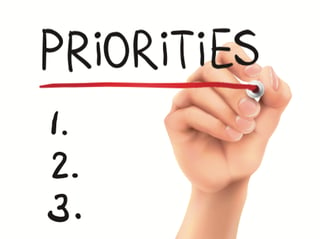What's the difference between KPIs (Key Performance Indicators) and Quarterly Rocks? This can be a very confusing  question, especially for companies who are new to using the Rockefeller Habits or Rhythm's Think Plan Do as a methodology to grow their company and drive their execution. It can be confusing at first as there are some similarities between the two. Both use clear success criteria to measure results or desired behavior, and quarterly rocks (often called priorities or projects) can often influence the success of the KPIs and metrics you are monitoring.
question, especially for companies who are new to using the Rockefeller Habits or Rhythm's Think Plan Do as a methodology to grow their company and drive their execution. It can be confusing at first as there are some similarities between the two. Both use clear success criteria to measure results or desired behavior, and quarterly rocks (often called priorities or projects) can often influence the success of the KPIs and metrics you are monitoring.
An easy way to begin thinking about the difference between the two is to view KPIs as something you measure and Priorities as something you do. Establishing the right KPIs will help you monitor results and drive specific behaviors that lead to the results you desire in specific areas of the business. Creating the right Priorities will help you focus your team's energy on the specific work you are doing to grow, improve or move the company forward. This is a key concept in Scaling Up and the Rockefeller Habits.
KPIs are broken down into two types: Leading KPIs and Lagging KPIs (often called Results Indicators). Leading Indicators help you manage the behavior needed to produce the results you are looking for. Let's use sales as an example to examine KPIs. Sales Revenue is a result. We need to know this number to make sure we are making progress on the targets we established at the beginning of the quarter or year. However, if we only monitor the results we have achieved, there is little chance we will achieve the goal we set. We need to peel the onion back and ask what behaviors we need to monitor in order to drive the results we desire. This will lead us to identify KPIs that monitor and drive behaviors - like Outbound Calls, Second Appointments, Qualified Leads, or Proposals Pending - that will result in hitting our goals. By managing and encouraging the right behavior, we are more likely to generate the results we are seeking. Therefore, KPIs will help us accomplish our goals and reach our targets if the sales machine is established and running smoothly.
But, what if the sales engine is not fully developed? What if we have to put systems, people and processes in place to reach our targets? This is where Priorities come in. If we need to develop a sales process, hire the right individuals to execute, create a sales strategy, or implement a Customer Relation Management System (CRM) to manage our sales activities and pipeline, we need to set Priorities to get this done. These are all example of priorities we might establish for the quarter to help us achieve our desired results. Priorities help us define the work we need to do to move the business forward. In order to be effective, Priorities must be clearly stated, begin with a verb, and be action oriented. The more clearly you state the Priority, the better chance you have of accomplishing it. Someone who has no idea about your business should be able to read it and understand what it means. You also need to establish clear outcome based success criteria to define what it is you are trying to accomplish. Each priority should have one owner and a due date. If we go back to one of the examples above, hire the right sales individuals, we might develop a priority (quarterly rock) that looks like this:
Quarterly Priority: Hire 3 new salespeople to service the southwest region.
Owner: Jim Brown
Due date: December 15th
Success Criteria:
Super Green: 2 candidates already beginning the on-boarding process
Green: Top 3 candidates identified and offers accepted
Yellow: Between Red and Green
Red: No candidates identified
I often tell clients, “You cannot measure yourself to results.” It takes clearly defined Priorities to determine the actual work you are going to do each quarter to ensure you make progress on achieving your Key Initiatives for the year. KPIs will help you measure many of the day-to-day activities necessary to run the business effectively. Priorities will help you take bigger steps forward to grow and improve the way the business operates.
Review your KPIs and Quarterly Rocks. Are you clear which are which, and do you have the right ones? We suggest no more than 12-18 KPIs to manage you day to day activities, that's 2-3 KPIs in each of 6 primary categories monitored at the executive level. We then suggest no more than 3-5 priorities for the company and 3-5 priorities for each individual on the executive team to do the work necessary to move the company forward for the quarter in an effort to reach the targets you established.
Spending the time and effort to get this right during Quarterly Planning will improve your execution and help you reach your goals. Good luck and please let me know your thoughts, Alan
You might be interested in reading these resources below:
25 KPI Examples for Manufacturing Companies
33 KPI Examples to Measure Productivity & Prevent Organizational Drag
Employee KPI Examples: How to Measure What (or Who) You Want to Move (Video)
KPI Examples for Successful Sales Teams
Rhythm Systems KPI Resource Center
Photo Credit: iStock by Getty Images




